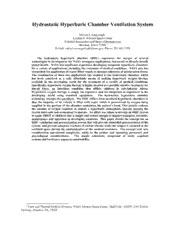
NASA Technical Reports Server (NTRS) 20110020789: Hydrostatic Hyperbaric Chamber Ventilation System PDF
Preview NASA Technical Reports Server (NTRS) 20110020789: Hydrostatic Hyperbaric Chamber Ventilation System
Hydrostatic Hyperbaric Chamber Ventilation System Miriam J. Sargusingh1 Lyndon B. Johnson Space Center National Aeronautics and Space Administration Houston, Texas 77058 E-Mail: [email protected]; Phone: 281.483.1358 The hydrostatic hyperbaric chamber (HHC) represents the merger of several technologies in development for NASA aerospace applications, harnessed to directly benefit global health. NASA has significant experience developing composite hyperbaric chambers for a variety of applications, including the treatment of medical conditions. NASA also has researched the application of water-filled vessels to increase tolerance of acceleration forces. The combination of these two applications has resulted in the hydrostatic chamber, which has been conceived as a safe, affordable means of making hyperbaric oxygen therapy available in the developing world for the treatment of a variety of medical conditions. Specifically, hyperbaric oxygen therapy is highly-desired as a possibly curative treatment for Buruli Ulcer, an infectious condition that afflicts children in sub-Saharan Africa. Hyperbaric oxygen therapy is simply too expensive and too dangerous to implement in the developing world using standard equipment. The hydrostatic hyperbaric chamber technology changes the paradigm. The HHC differs from standard hyperbaric chambers in that the majority of its volume is filled with water which is pressurized by oxygen being supplied in the portion of the chamber containing the patient’s head. This greatly reduces the amount of oxygen required to sustain a hyperbaric atmosphere, thereby making the system more safe and economical to operate. An effort was taken to develop an HHC system to apply HBOT to children that is simple and robust enough to support transport, assembly, maintenance and operation in developing countries. This paper details the concept for an HHC ventilation and pressurization system that will provide controlled pressurization of the system, and provide adequate washout of carbon dioxide while the subject is enclosed in the confined space during the administration of the medical treatment. The concept took into consideration operational complexity, safety to the patient and operating personnel, and physiological considerations. The simple schematic, comprised of easily acquired commercial hardware, supports sustainability. 1 Crew and Thermal Systems Division, NASA Johnson Space Center, Mail Code: AES29, 2101 NASA Parkway, Houston, TX, 77058
